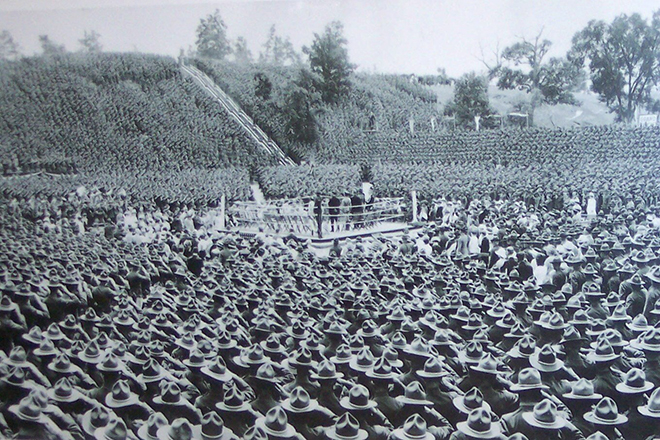Rockford’s Camp Grant was ‘born’ in 1917

Camp Grant soldiers in the ‘Bell Bowl” during the First World War.
Some 5,810 acres of farmland located several miles south of where Rockford’s east side ended in 1917 were leased and then purchased and designated by the War Department for a Midwest military training facility.
The Camp, named in honor of General Ulysses S. Grant, was the largest military training facility in the Midwest in 1917, and the Camp really brought an economic boom to the area.
“There were 8,000 construction workers who came to build the camp,” as noted by the late Camp Grant “buff,” Terry Dyer of Roscoe some years ago. “Locally, wages tripled. It was the largest construction project this area ever witnessed.”
Dyer explained that the first draftees arrived in September of that year with a focus on infantry-related field skills. Records show that 56,238 troops trained there during the First World War. In September of 1918, the Spanish influenza epidemic wreaked havoc on the Camp and areas throughout the country. Over 1,400 soldiers died.
The Camps’ commander committed suicide over losing so many of those soldiers. Rockford resident Clara Danielson, who lived to be over 95 years old, recalled seeing wagons “loaded with dead soldiers piled like cord wood making their way down Kishwaukee Street from the Camp.”
After the war ended, Dyer stated, “Many of the buildings were sold off or were burned. The government turned over the land to the State of Illinois, along with one million dollars to rebuild the Camp for use by the 33rd National Guard, Illinois Prairie Division. During the Great Depression, it became a ‘tent city,’ and was also used by Civilian Conservation Corps members and WPA personnel. There was also a group that was the forerunner of today’s ROTC and consisted of over 1,000 teenage boys staying at the camp at various times who came from not only Rockford, but also Chicago, Milwaukee and Detroit.”
In October of 1940, Camp Grant was reactivated as an induction center and a medical training post for draftees. At a cost of $9 million dollars and through the work for 7,000 construction workers, Camp Grant was rebuilt. An estimated 100,000 medical personnel were trained at the Camp and at the height of the Second World War; it was the nation’s largest induction center. The Camp also served as a German Prisoner of War detention center, and 6,000 civilians were employed there.
“The bulk of the approximate 2,500 German prisoners held at Camp Grant came from Field Marshall Erwin Rommel’s ‘Deutsches Afrika Korps,’ and had surrendered to the Allies at Tunis in 1943,” Dyer explained. “The first group arrived here in August of that year. There were also some U-Boat and Luftwaffe prisoners held here.”
German prisoners worked on area farms and in some local factories while at Camp Grant and earned a small income through their work, which Dyer said, “They used to purchase toiletries and other items at the PX. One of the biggest employers was the Quaker Oats Company in Rockford. The Germans were able to work there after the company’s union members voted to allow them in. Del Monte in Rochelle also used a number of the German workers.” Sundstrand Machine and Tool, Woodward Governor, Barber Coleman and Greenlee Tool took in the more experienced and knowledgeable German machinists.
Many workers had a more agricultural background and worked on farms in such places as DeKalb, Belvidere, Sycamore, Hampshire, Shabbona, Kirkland and Lanark. Dyer noted, “I remember speaking with one lady who lived in Sycamore as a child and recalled the Germans staying in a building across from where her family lived. They worked in a hemp factory during the week and were taken back to Camp Grant on weekends. She said many of the Germans were very well educated and some spoke English perfectly; she remembered them as being friendly and that they used to give the children candy and gum.”
“By and large they were a good group of prisoners, the problem prisoners were sent elsewhere,” Dyer said. “They did undergo some culture shock upon their arrival here. They were stunned by the immense vastness of this country. I heard of one POW who was driven to tears when on his first day in the Camp, a bowl of vanilla ice cream was placed in front of him for dessert. Another interesting thing was that in this country we enjoy corn on the cob. Offering that to the Germans was taken as an insult because in Germany they didn’t eat corn. That was for feed for the pigs. Once they saw that everyone here ate it and enjoyed it, they looked at it a little differently. Also, we have white bread here; they were familiar with a hard and dark bread and didn’t think much of bread that was so soft.”
At the end of the war, all of the POWs were sent home. Dyer wasn’t aware of any who came back to settle in this area. In September of 1945, Camp Grant was closed for the last time and today is the site of the Greater Chicagoland/Rockford Airport.



